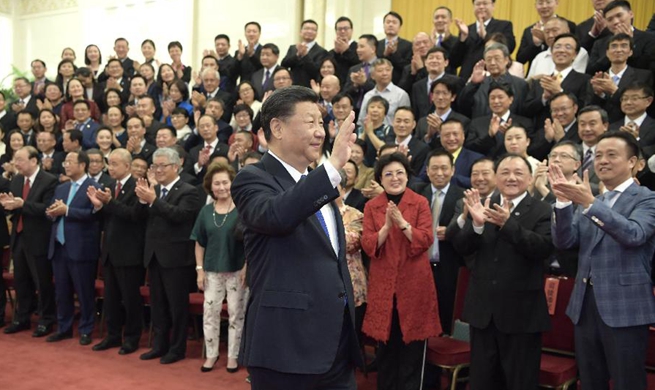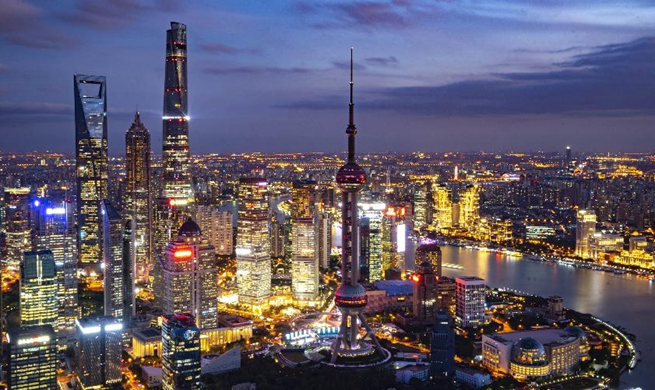BEIJING, May 29 (Xinhua) -- In spite of increasing uncertainties both at home and abroad, China's foreign trade will continue to hold up well in 2019 as there are still many favorable conditions for the country to weather through the challenges.
The World Trade Organization (WTO) last month lowered its forecast for global trade growth this year from 3.7 percent to 2.6 percent, due to high levels of uncertainties from trade tensions.
Domestically, the traditional path of relying on low labor and production costs for export growth is running to its end and new competitive edges are yet to flourish.
While acknowledging the "grim situation," China's Ministry of Commerce (MOC) reckons in the latest report that the foundations for stable growth remain largely intact as improved policy support, domestic industrial upgrading and transformation of foreign trade structure will combine to sustain growth.
LIMITED IMPACT OF U.S. TARIFF HIKES
In an escalation of trade tensions, the United States on May 10 announced a decision to increase additional tariffs on 200 billion U.S. dollars worth of Chinese imports from 10 percent to 25 percent.
The move prompted China to adopt similar policies by raising the rate of additional tariffs imposed on some of the imported U.S. products from June 1.
Guo Shuqing, chairman of the China Banking and Insurance Regulatory Commission, said that U.S. tariff hikes will have limited impact on the Chinese economy and the country has the capacity and confidence to cope with it.
Domestic consumption has become the most significant driving force for China's economic growth, and most of the products exported to the U.S. for example, are suitable for sales in domestic markets, Guo said.
Meanwhile, Chinese products have been seeing expanding markets in more countries and regions. Official data showed China's trade with Belt and Road countries totaled 2.73 trillion yuan in the first four months of 2019, up 9.1 percent year on year, more than doubling the overall pace.
STRONGER POLICY SUPPORT
Since last year, China has rolled out a slew of new measures, including cutting customs clearance time, streamlining port services and improving export tax rebate policy, to reduce business burdens and bolster foreign trade.
Effective from Nov. 1 last year, the 15-percent bracket for a tax rebate and part of the 13-percent bracket had been lifted to 16 percent, with the 9-percent notch adjusted to 10 percent or 13 percent, and the 5-percent tier to 6 or 10 percent.
The government has also introduced policies to encourage financial institutions to increase the use of the credit loan under export credit insurance and the export tax rebate account pledged loan to scale up financing support to trade companies, especially the micro, small and medium-sized ones.
To stimulate imports, China has lowered import tariffs on numerous commodities for several times in 2018, bringing the overall tariff level down from 9.8 percent to 7.5 percent, according to the MOC report.
In 2019, the Chinese government will step up support for the imports of advanced technologies, important equipment and key components.
DOMESTIC DEVELOPMENT AS STABILIZER
As China is experiencing further consumption and industrial upgrading, high-quality development of the country's economy will continue to lay a solid foundation for its foreign trade, the MOC said.
While the IMF downgraded 2019 global growth forecast by 0.2 percentage points to 3.3 percent last month, it revised its projection for China to 6.3 percent, up 0.1 percentage point from its previous estimation in January.
The MOC report pointed out that industrial upgrading and the rapid development of strategic emerging industries have injected new impetus in foreign trade growth, leading to rapid growth in export of high-quality, high-tech and high-value-added products.
In 2018, the import and export of mechanical and electrical products reached a record high of 2.4 trillion U.S. dollars, while that of high-tech products came in at 1.4 trillion dollars, accounting for 30.7 percent of the total foreign trade, the report said.
In addition, the country is constructing a transformation base for foreign trade, international marketing service network and a trade promotion platform to optimize its foreign trade structure.
New modes of foreign trade such as cross-border e-commerce will be further supported as the country is conducting the pilot of 35 cross-border e-commerce zones, the report said.

















